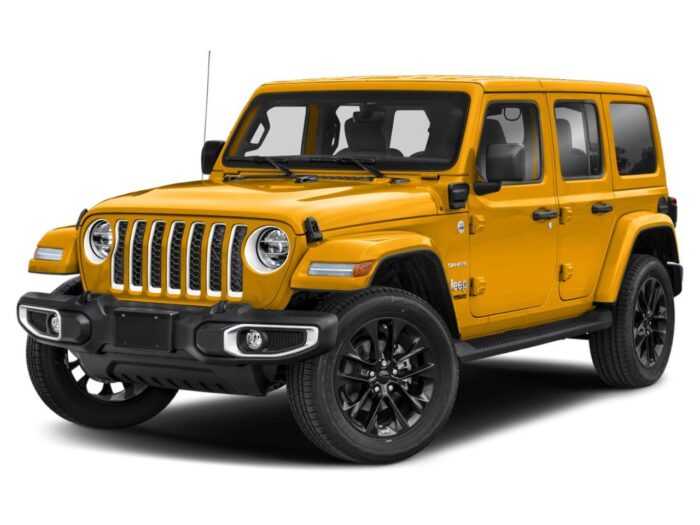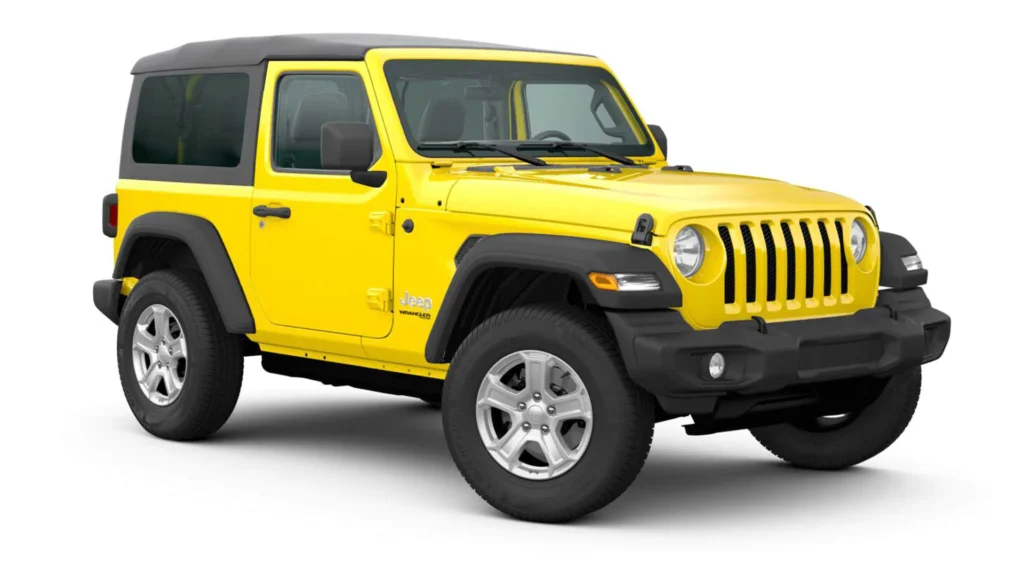In this comprehensive guide, we will dive into the depths of tire pressure, revealing the recommended figures for different Jeep Wrangler generations, trim levels, and engines. We’ll even unravel the mystery of resetting the dreaded low tire pressure light. So grab your adventure hat, buckle up, and let’s roll!
Understanding Tire Pressure Terminology:
Before we dive deeper into the world of Jeep Wrangler tire pressure, let’s familiarize ourselves with some key terminology:
- PSI: PSI stands for “pounds per square inch” and is the standard unit for measuring tire pressure.
- Recommended Tire Pressure: This refers to the manufacturer’s recommended pressure level for your specific Jeep Wrangler model.
- Overinflation: Overinflation occurs when the tire pressure exceeds the recommended level. It can lead to reduced traction, increased risk of blowouts, and uneven wear on the tire’s center tread.
- Underinflation: Underinflation is the condition where the tire pressure is below the recommended level. It can result in decreased fuel efficiency, poor handling, overheating, and increased risk of tire damage.
The Importance of Proper Tire Pressure
Before we unveil the specific tire pressure values, let’s take a moment to understand why it matters. Maintaining the correct tire pressure offers numerous benefits, including:
- Safety: Optimal tire pressure ensures better traction, reduces the risk of blowouts, and enhances overall vehicle stability.
- Fuel Efficiency: When your tires are properly inflated, your Jeep Wrangler can cruise more efficiently, translating to improved fuel economy.
- Tire Longevity: Overinflated or underinflated tires wear out faster, leading to premature replacement costs. By following the recommended pressure guidelines, you can extend the lifespan of your tires.
- Ride Comfort: Just like Goldilocks, finding the right balance is key. Proper tire pressure contributes to a smoother and more comfortable driving experience.
Recommended Tire Pressure for Different Jeep Wrangler Generations
The tire pressure values can vary depending on the generation of your Jeep Wrangler. Below, we present a table showcasing the recommended figures for each generation:
| Generation | Recommended Tire Pressure (Front) | Recommended Tire Pressure (Rear) |
|---|---|---|
| JK (2007-2018) | 36 PSI | 36 PSI |
| JL (2018-Present) | 33 PSI | 33 PSI |
Recommended Tire Pressure for Different Jeep Wrangler Trim Levels
The trim level of your Jeep Wrangler can also influence the recommended tire pressure. Refer to the table below to find the ideal values based on your trim level:
| Trim Level | Recommended Tire Pressure (Front) | Recommended Tire Pressure (Rear) |
|---|---|---|
| Sport | 35 PSI | 35 PSI |
| Sahara | 37 PSI | 37 PSI |
| Rubicon | 40 PSI | 40 PSI |
Recommended Tire Pressure for Different Jeep Wrangler Engines
Did you know that even the engine type of your Jeep Wrangler can impact the recommended tire pressure? Check out the table below for the optimal values corresponding to each engine variant:
| Engine Type | Recommended Tire Pressure (Front) | Recommended Tire Pressure (Rear) |
|---|---|---|
| 2.0L Turbo | 34 PSI | 34 PSI |
| 3.6L V6 | 37 PSI | 37 PSI |
| 3.0L Diesel | 36 PSI | 36 PSI |
Tire Pressure Guidelines for Jeep Wrangler by Year of Production
To make things easier for you, we’ve compiled a table with the recommended tire pressure for each year of Jeep Wrangler production. Remember, these values are approximate and may vary based on factors such as tire brand and driving conditions. It’s always best to consult your vehicle’s manual and double-check with a tire professional.
| Year of Production | Recommended Tire Pressure (PSI) |
|---|---|
| 2010 | 33 front, 33 rear |
| 2011 | 35 front, 35 rear |
| 2012 | 34 front, 34 rear |
| 2013 | 36 front, 36 rear |
| 2014 | 33 front, 33 rear |
| 2015 | 35 front, 35 rear |
| 2016 | 34 front, 34 rear |
| 2017 | 36 front, 36 rear |
| 2018 | 33 front, 33 rear |
| 2019 | 35 front, 35 rear |
| 2020 | 34 front, 34 rear |
| 2021 | 36 front, 36 rear |
| 2022 | 33 front, 33 rear |
| 2023 | 35 front, 35 rear |
| 2024 | 35 front, 35 rear |

Tire Pressure Considerations for Summer and Winter Tires
Tire pressure is not a one-size-fits-all concept. It’s essential to adapt your tire pressure depending on the type of tire you’re using and the prevailing weather conditions. Here are a few pointers to keep in mind:
Summer Tires:
When you equip your Jeep Wrangler with summer tires, you should consider adjusting the tire pressure accordingly. As a general rule of thumb, it’s advisable to increase the tire pressure by approximately 2-4 PSI above the recommended values for your specific year of production. This slight increase helps optimize handling and performance during warmer months.
Winter Tires:
Winter conditions demand special attention to ensure your Jeep Wrangler can tackle snow, ice, and slippery surfaces. When using winter tires, you should decrease the tire pressure by approximately 2-4 PSI below the recommended values for your specific year of production. This adjustment enhances traction and stability, allowing your vehicle to handle winter conditions with confidence.
Factors Affecting Tire Pressure:
Several factors can impact tire pressure over time. Understanding these factors will help you stay proactive in maintaining the correct pressure levels. Here are the key factors to consider:
- Temperature: As temperature changes, tire pressure fluctuates. Colder temperatures cause tire pressure to decrease, while warmer temperatures cause it to increase.
- Driving Conditions: Off-roading, rough terrains, and heavy loads can affect tire pressure. These conditions may require adjusting the pressure accordingly.
- Tire Age and Wear: Older tires and those with uneven wear patterns may experience variations in pressure. Regularly inspecting and replacing worn-out tires is essential for maintaining optimal tire pressure.
- Air Leakage: Slow air leakage over time is a common occurrence. Regularly checking and adjusting tire pressure helps combat this issue.
How to Check Jeep Wrangler Tire Pressure:
Regularly checking your Jeep Wrangler’s tire pressure is crucial to ensure it stays within the recommended range. By following a few simple steps, you can keep your tires properly inflated. Here’s a step-by-step guide to checking your Jeep Wrangler tire pressure:
Tools for Checking Tire Pressure:
Before you start, gather the following tools:
- Tire Pressure Gauge: This handy tool allows you to measure the pressure inside your tires accurately.
- Tire Inflator: In case your tires require additional air, a tire inflator will come in handy.
Step-by-Step Guide to Checking Tire Pressure:
- Park on a level surface: Find a flat surface to park your Jeep Wrangler, ensuring it is on a level plane.
- Locate the recommended tire pressure: Refer to your vehicle’s manual or the tire placard on the driver’s side door jamb to identify the recommended tire pressure.
- Remove the valve cap: Unscrew the valve cap from the tire’s valve stem.
- Attach the tire pressure gauge: Firmly press the gauge onto the valve stem and ensure a proper seal.
- Read the pressure: The tire pressure gauge will display the current pressure. Compare it to the recommended pressure to determine if any adjustment is necessary.
- Adjust the pressure if needed: If the pressure is too low, use a tire inflator to add air. If it’s too high, carefully release air until the desired pressure is reached.
- Repeat for all tires: Follow the same process for each tire on your Jeep Wrangler, including the spare tire if applicable.
- Recheck the pressure: After adjusting the pressure, recheck each tire to ensure they all meet the recommended levels.
How to Adjust Tire Pressure:
If your Jeep Wrangler’s tire pressure is too low or too high, it’s crucial to make the necessary adjustments. Properly inflating your tires will ensure optimal performance and safety. Here are some tips for adjusting your tire pressure:
- Adding Air: To increase tire pressure, use a tire inflator or visit a nearby gas station with an air pump. Add air in small increments, checking the pressure regularly to avoid overinflation.
- Releasing Air: If the tire pressure is too high, use a small tool like a valve core tool or a pen tip to press the center pin inside the valve stem. This will release air gradually. Check the pressure frequently to avoid underinflation.
Resetting the Low Tire Pressure Light
Now that we’ve mastered the art of tire pressure, let’s tackle the vexing issue of the low tire pressure light. Here’s a step-by-step guide to resetting it:
- Check the tire pressures: Use a reliable tire pressure gauge to ensure that all tires are properly inflated according to the recommended values discussed earlier.
- Locate the reset button: The reset button is typically located on the dashboard or steering column. Look for a small button labeled “TPMS” or “Reset.”
- Turn on the ignition: Start your Jeep Wrangler, but make sure you keep it in the “off” position.
- Press and hold the reset button: Press and hold the reset button for about three seconds until the low tire pressure light starts blinking.
- Release the reset button: After the light blinks, release the reset button. The low tire pressure light should now turn off.
